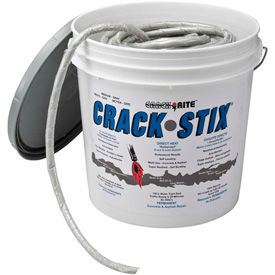
- CRACK STIX ASPHALT PATCH
- CRACK STIX ASPHALT CRACK
Some additives also give the asphalt a darker and more aesthetic appearance. Latex and similar additives are added to a sealer to help it bond to the asphalt, extend its longevity, reduce drying time, and make the finished seal more solvent resistant. Sand is added for surface traction to prevent people from slipping or car tires from skidding.
CRACK STIX ASPHALT CRACK
While epoxy and acrylic crack fillers are more expensive than coal tar or asphalt products, they offer a longer-lasting seal and prevent unsightly driveway stains.Īlong with the primary base ingredient, crack fillers often include compounds like sand, latex, and other additives. Acrylic and epoxy formulas are preferred in hot and sunny climates because of their superior UV protection. The main difference between the two formulas is that epoxy is usually thicker, lasts longer, and is often more expensive than acrylic formulas.
Epoxy and acrylic crack fillers are fairly similar to one another and offer benefits like UV protection, a longer lifespan, and oil- or gas-stain resistance. Just like coal tar, asphalt formulas are susceptible to UV degradation and solvent staining. The ropes are packed into cracks and melted with a blowtorch to completely and permanently seal the crack. Another popular option is filler ropes, which are composed of thin, ropy strips of asphalt emulsion. Asphalt-based formulas can be found in bulk solutions to seal entire driveways or fill individual cracks. They are generally affordable and highly durable.  Asphalt-based crack fillers are a safer and more environmentally-friendly alternative to coal tar sealers. Other disadvantages include coal tar’s susceptibility to UV degradation and staining. For this reason, coal tar asphalt fillers have largely fallen out of favor and have been banned (or regulated) in several states. Though coal tar is an affordable sealing solution, the material emits large amounts of toxic and environmentally detrimental volatile organic compounds (VOCs). Coal tar sealers are often mixed with water and polymers to help with spreading, since the consistency of pure coal tar would be too thick to use. Coal tar crack fillers contain a thick and sticky material made from coal, and are more commonly used in sealer products that cover the entire driveway. Of these, asphalt and coal tar are the most common base ingredients. Most asphalt crack fillers are made primarily with asphalt, coal tar, acrylic, and epoxy. The following key characteristics can help you choose the best asphalt driveway crack filler for your specific situation.
Asphalt-based crack fillers are a safer and more environmentally-friendly alternative to coal tar sealers. Other disadvantages include coal tar’s susceptibility to UV degradation and staining. For this reason, coal tar asphalt fillers have largely fallen out of favor and have been banned (or regulated) in several states. Though coal tar is an affordable sealing solution, the material emits large amounts of toxic and environmentally detrimental volatile organic compounds (VOCs). Coal tar sealers are often mixed with water and polymers to help with spreading, since the consistency of pure coal tar would be too thick to use. Coal tar crack fillers contain a thick and sticky material made from coal, and are more commonly used in sealer products that cover the entire driveway. Of these, asphalt and coal tar are the most common base ingredients. Most asphalt crack fillers are made primarily with asphalt, coal tar, acrylic, and epoxy. The following key characteristics can help you choose the best asphalt driveway crack filler for your specific situation. 
Since cracks come in many shapes and sizes, it’s important to select a product that’s formulated for the type of cracks most prevalent on your driveway. Photo: What to Consider When Choosing the Best Asphalt Driveway Crack Filler
BEST FILLER ROPE: Latex-ite Pli-Stix Blacktop Joint and Crack Filler. BEST FAST DRYING: Gardner Drive Seal Driveway Filler and Sealer. CRACK STIX ASPHALT PATCH
BEST ECO-FRIENDLY: QPR 50-Pound Asphalt Patch.
 BEST EPOXY: Rust-Oleum 2-Gallon Blacktop Coating Resurfacer. BEST BANG FOR THE BUCK: Red Devil 0637 Acrylic Asphalt Crack Filler Sealant. RUNNER UP: Latex-ite 4.75-Gallon Sand Mix Driveway Filler Sealer. BEST OVERALL: Crack-Stix Permanent Blacktop Crack Filler. Read on to learn about the key characteristics to consider while shopping, and discover some of the best asphalt driveway crack filler options available. Fortunately, there are products on the market that allow you to seal asphalt cracks without having to hire a contractor. Sealing cracks soon after they appear is one of the best things you can do to extend the longevity of your asphalt driveway. These cracks can also accumulate dirt, debris, and weeds may grow within them. They allow moisture to seep into the asphalt, which can erode the base of your driveway and cause the cracks to widen as the water freezes and thaws. Driveway cracks may be unsightly, but they can also lead to more extensive damage if left untreated.
BEST EPOXY: Rust-Oleum 2-Gallon Blacktop Coating Resurfacer. BEST BANG FOR THE BUCK: Red Devil 0637 Acrylic Asphalt Crack Filler Sealant. RUNNER UP: Latex-ite 4.75-Gallon Sand Mix Driveway Filler Sealer. BEST OVERALL: Crack-Stix Permanent Blacktop Crack Filler. Read on to learn about the key characteristics to consider while shopping, and discover some of the best asphalt driveway crack filler options available. Fortunately, there are products on the market that allow you to seal asphalt cracks without having to hire a contractor. Sealing cracks soon after they appear is one of the best things you can do to extend the longevity of your asphalt driveway. These cracks can also accumulate dirt, debris, and weeds may grow within them. They allow moisture to seep into the asphalt, which can erode the base of your driveway and cause the cracks to widen as the water freezes and thaws. Driveway cracks may be unsightly, but they can also lead to more extensive damage if left untreated.







 0 kommentar(er)
0 kommentar(er)
